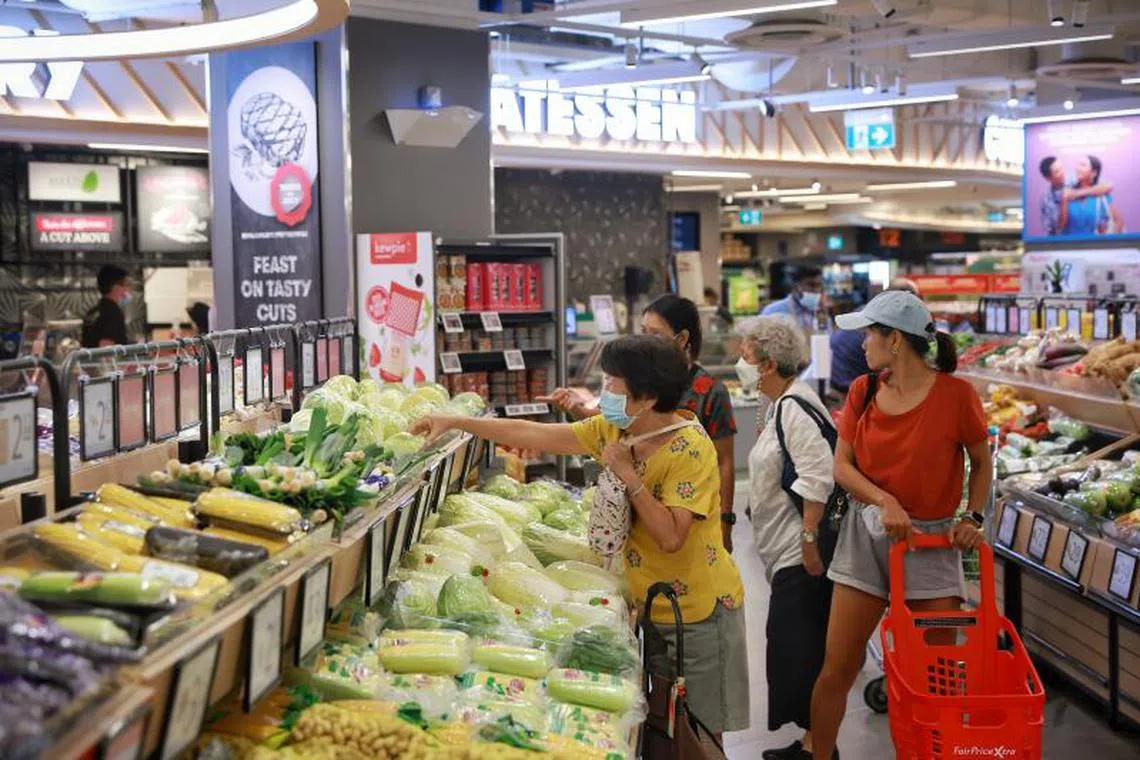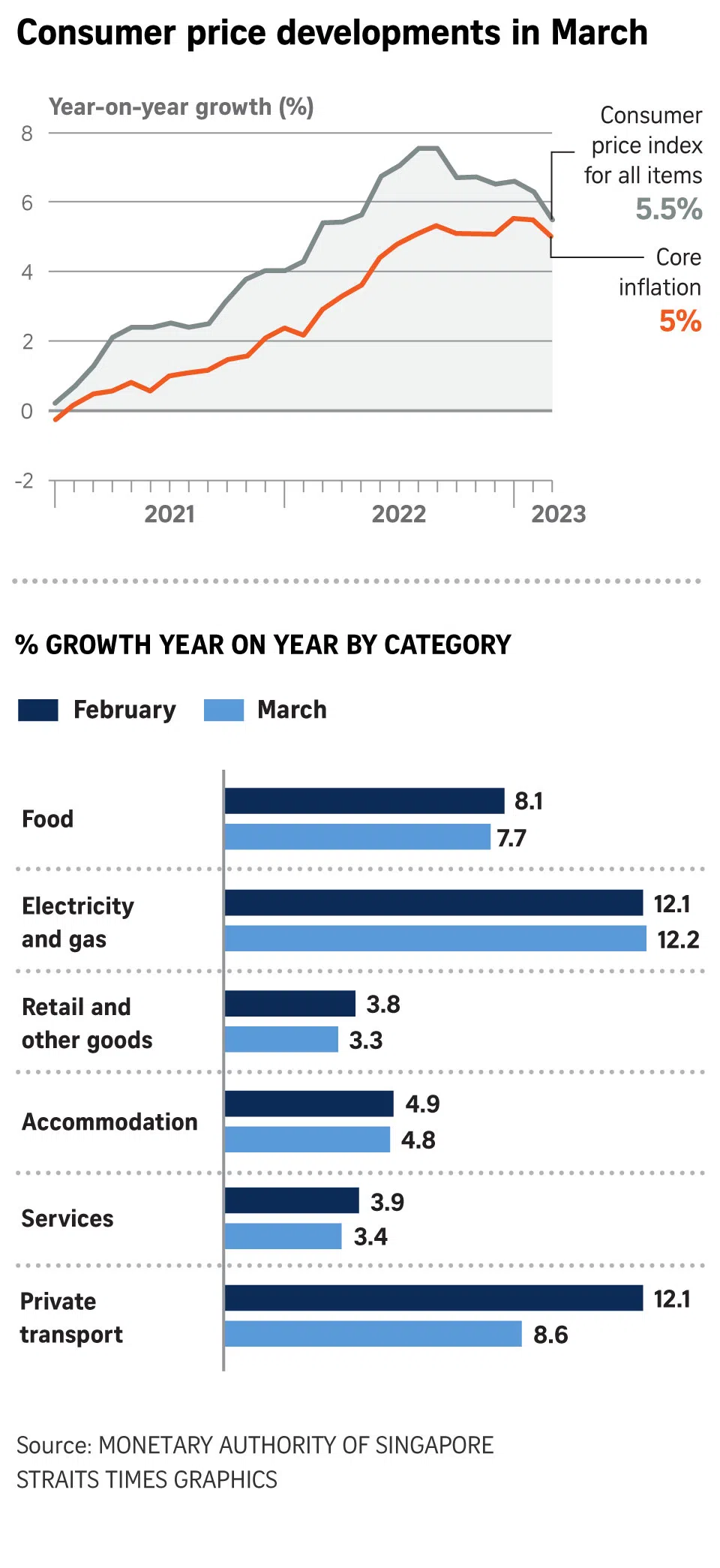Singapore core and headline inflation ease in March, providing some respite
Sign up now: Get ST's newsletters delivered to your inbox

For the second straight month this year, the headline consumer price index, or overall inflation, continued to ease.
ST PHOTO: KEVIN LIM
Follow topic:
SINGAPORE – In a sign that respite may have arrived, both core inflation and head-line inflation eased in March after peaking in past months.
Core consumer prices – which exclude private transport and accommodation costs, and thus reflect the expenses of Singapore households more accurately – rose 5 per cent year on year in March. This is lower than the 5.5 per cent recorded in February, a figure that is the highest since November 2008.
The easing in core inflation came on the back of lower price increases in services, food, retail and other goods.
For the second straight month in 2023, the headline consumer price index, or overall inflation, continued to ease. It slid to 5.5 per cent in March, down from 6.3 per cent in February and 6.6 per cent in January,
Both core inflation and headline inflation in March are marginally lower than Reuters’ estimates.
The official projections for the year remain unchanged at between 5.5 per cent and 6.5 per cent for headline inflation, with core inflation forecast at between 3.5 per cent and 4.5 per cent. These estimates take into account the goods and services tax hike from 7 per cent to 8 per cent from Jan 1.
Energy and food commodity prices have fallen below their peaks seen in 2022, and this has resulted in a decline in Singapore’s import prices on a year-on-year basis, said the Monetary Authority of Singapore and the Ministry of Trade and Industry on Monday.
They added that businesses are expected to pass down costs to consumers at a more moderate pace, while car and accommodation cost increases could stay firm in the quarters ahead on the back of tight certificate of entitlement quotas for cars and strong demand for rental housing.
Core inflation is expected to stay elevated in the next few months, said the authorities. “Nonetheless, it will remain on a broad moderating path, before slowing more discernibly in the second half of 2023 as imported inflation falls further and the current tightness in the domestic labour market eases.”
CIMB economist Song Seng Wun said the higher base from which comparisons on an annual basis are made explains why core and head-line inflation have moderated.
“The start of the Ukraine war at end-February 2022 caused energy and food prices, especially grain prices, to soar. Prices have moderated since,” he said.
Mr Song expects moderation to be more significant from the middle of the year, given the high base in 2022. “Short of another external shock that will cause the costs of food prices and services to jump, the base effect will help on the annual (comparison) side.”
In addition, although the growth in prices of items such as ice kacang may have eased, he said the month-on-month data shows that prices are still sticky and are being passed through to consumers.
Maybank economist Chua Hak Bin thinks inflation will likely continue to ease but at a gradual pace, with the fall largely driven by easing import prices.
Higher labour costs may keep inflation sticky, he said.
“A potential recession and employment downturn may accelerate the easing in inflation pressures,” said Dr Chua, who noted that Singapore may slip into a technical recession if the boost from China’s reopening fails to materialise in the second quarter.
Barclays senior regional economist Brian Tan said the visible fall in March is attributable to base effects, especially from food prices and the inclusion of Covid-19 travel test costs in March 2022.
He said sequential price pressures appear to have cooled further in March this year and maintained his base case for no monetary policy tightening this year.
Private transport inflation fell the most to 8.6 per cent in March, from 12.1 per cent in February. This was due to a smaller hike in car prices and a steeper decline in petrol costs.
Services inflation moderated to 3.4 per cent in March as point-to-point transport fares rose at a slower pace and other transport services costs fell.
Inflation for retail and other goods dipped to 3.3 per cent as the prices of personal care products and household durables rose at a slower pace, while prices of telecommunication equipment fell.
Food inflation also went down slightly, dropping to 7.7 per cent on the back of smaller increases in the prices of prepared meals and non-cooked food.
Accommodation inflation edged down a notch to 4.8 per cent as the pace of hikes in housing rents moderated.
Electricity and gas was the only category that bucked the trend, with inflation rising slightly to 12.2 per cent due to a larger increase in electricity costs.



